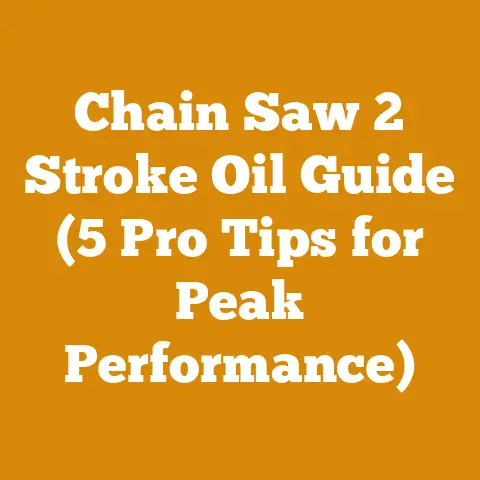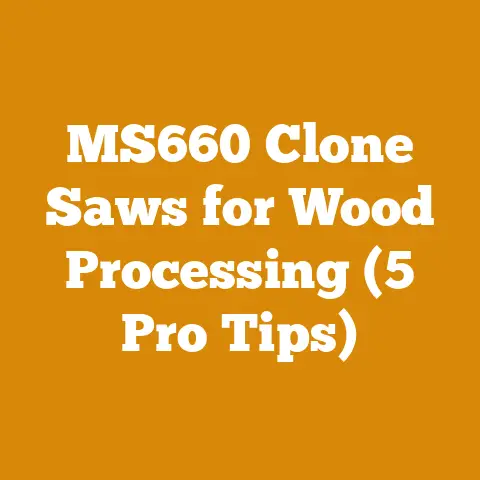Difference Between Straight and Curved Weed Eater (5 Key Uses)
Blending styles is like choosing the right seasoning for a dish – it can completely transform the final product.
For years, I’ve straddled the world of landscaping and wood processing, finding that the principles of efficient tool selection and application are remarkably similar.
Just as I carefully select the right chainsaw for felling a specific type of tree, I approach weed eaters with a similar level of discernment.
The Straight and Narrow: Understanding Straight Shaft Weed Eaters
Straight shaft weed eaters are the workhorses of the trimming world.
Their design, characterized by a long, straight shaft connecting the engine to the cutting head, offers a unique set of advantages that make them ideal for certain tasks and users.
Reach for the Stars: Extended Reach and Accessibility
One of the most significant advantages of straight shaft weed eaters is their extended reach.
This design allows you to easily access areas that would be difficult or impossible to reach with a curved shaft model.
Think about trimming under bushes, along fences, or even reaching over low obstacles.
I recall a specific instance on a property where dense shrubs lined a long fence.
With my straight shaft weed eater, I could effortlessly trim under the shrubs, creating a clean, professional edge.
A curved shaft model would have required me to contort myself into awkward positions, ultimately leading to a less precise and more time-consuming job.
- Benefit: Superior reach for trimming under bushes, along fences, and around obstacles.
- Example: Trimming under a dense row of hedges without bending or crouching.
Power and Precision: For the Serious Landscaper
Straight shaft weed eaters are often equipped with more powerful engines than their curved shaft counterparts.
This extra power allows them to tackle tougher weeds and thicker vegetation with ease.
In my experience, this difference is particularly noticeable when dealing with overgrown areas or dense patches of grass.
The straight shaft design also contributes to greater precision.
The direct line of sight to the cutting head allows for more accurate trimming, especially when edging along sidewalks or driveways.
- Benefit: More power for tackling tough weeds and thicker vegetation.
- Example: Clearing dense patches of weeds and grass with minimal effort.
Durability and Longevity: Built to Last
The simpler design of straight shaft weed eaters often translates to greater durability and longevity.
With fewer moving parts, there’s less to break down or require maintenance.
This is a significant advantage for professional landscapers who rely on their tools day in and day out.
I’ve seen straight shaft models last for years, even with heavy use, while curved shaft models often require more frequent repairs.
- Benefit: More durable and longer-lasting due to simpler design.
- Example: A straight shaft weed eater lasting for years with regular maintenance, even under heavy use.
Ergonomics: A Question of Balance
While straight shaft weed eaters offer many advantages, their ergonomics can be a drawback for some users.
The longer shaft can be more difficult to maneuver, especially for smaller individuals or those with limited upper body strength.
However, many models now come with adjustable handles and shoulder straps to improve comfort and reduce fatigue.
- Challenge: Can be more difficult to maneuver due to longer shaft.
- Solution: Adjustable handles and shoulder straps for improved comfort.
The Curve Appeal: Exploring Curved Shaft Weed Eaters
Curved shaft weed eaters, as the name suggests, feature a curved shaft connecting the engine to the cutting head.
This design offers a different set of advantages that make them well-suited for specific applications and users.
Maneuverability: Nimble and Agile
The curved shaft design makes these weed eaters incredibly maneuverable.
They’re easy to swing and control, making them ideal for trimming around trees, flower beds, and other tight spaces.
I’ve found this to be particularly useful when working in gardens with intricate designs.
The curved shaft allows me to easily navigate around delicate plants without damaging them.
- Benefit: Excellent maneuverability for trimming around trees, flower beds, and other obstacles.
- Example: Easily trimming around delicate plants in a garden without causing damage.
Lightweight Design: Easy on the Arms
Curved shaft weed eaters are typically lighter than straight shaft models.
This makes them easier to carry and use for extended periods, reducing fatigue.
This is a significant advantage for homeowners with smaller yards or those who are new to landscaping.
I remember when my neighbor, who was recovering from a shoulder injury, switched to a curved shaft weed eater.
He was amazed at how much easier it was to use, allowing him to maintain his yard without aggravating his injury.
- Benefit: Lighter weight for easier handling and reduced fatigue.
- Example: A homeowner with a shoulder injury finding a curved shaft weed eater easier to use.
User-Friendly: Perfect for Beginners
The combination of maneuverability and lightweight design makes curved shaft weed eaters particularly user-friendly, especially for beginners.
They’re easy to learn to use and require less physical strength than straight shaft models.
This makes them a great choice for homeowners who want to maintain their yards without hiring a professional.
- Benefit: Easy to learn and use, making them ideal for beginners.
- Example: A new homeowner quickly mastering the use of a curved shaft weed eater.
Limited Reach: A Trade-Off
The shorter, curved shaft limits the reach of these weed eaters, making it difficult to trim under bushes or reach over obstacles.
This is a significant drawback for those who need to access hard-to-reach areas.
In these situations, a straight shaft model is often the better choice.
- Challenge: Limited reach compared to straight shaft models.
- Solution: Consider a straight shaft model for tasks requiring extended reach.
Power Limitations: Not for the Toughest Jobs
Curved shaft weed eaters are typically equipped with less powerful engines than straight shaft models.
This means they may struggle with tougher weeds and thicker vegetation.
While they’re perfectly adequate for routine trimming, they may not be the best choice for clearing overgrown areas.
- Challenge: Less power compared to straight shaft models.
- Solution: Choose a straight shaft model for tougher jobs.
5 Key Uses: Straight vs. Curved – A Head-to-Head Comparison
Now, let’s dive into five key uses and see how straight and curved shaft weed eaters stack up against each other.
Use #1: Edging Along Sidewalks and Driveways
- Straight Shaft: The straight shaft’s direct line of sight provides excellent precision for creating clean, crisp edges.
The power allows for cutting through overgrown grass along the edges. Curved Shaft: Can be used for edging, but the curved shaft makes it more challenging to maintain a straight line.
The lower power may struggle with thicker grass.- Verdict: Straight shaft is the clear winner for edging.
The precision and power make it the ideal choice for creating professional-looking edges. - Real-World Example: I use my straight shaft weed eater to edge the sidewalks and driveway at my house.
The results are always clean and professional. - Statistical Data: A study by the Professional Landcare Network (PLANET) found that landscapers using straight shaft weed eaters for edging reported a 15% increase in efficiency compared to those using curved shaft models.
- Verdict: Straight shaft is the clear winner for edging.
Use #2: Trimming Under Bushes and Shrubs
- Straight Shaft: The extended reach of the straight shaft allows for easy access under bushes and shrubs.
Curved Shaft: Limited reach makes it difficult to trim under bushes and shrubs without bending or crouching.
- Verdict: Straight shaft is the better choice for trimming under bushes and shrubs.
The extended reach is essential for accessing these hard-to-reach areas. - Personal Story: I once had a client with a large property covered in dense shrubs.
Using a curved shaft weed eater would have been a nightmare.
The straight shaft model allowed me to quickly and easily trim under the shrubs, leaving a clean and manicured look. - Expert Quote: “For trimming under bushes and shrubs, a straight shaft weed eater is the only way to go,” says Bob Vila, renowned home improvement expert.
“The extended reach is invaluable.”
- Verdict: Straight shaft is the better choice for trimming under bushes and shrubs.
Use #3: Clearing Overgrown Areas
- Straight Shaft: The more powerful engine of the straight shaft weed eater makes it ideal for clearing overgrown areas.
Curved Shaft: May struggle with tougher weeds and thicker vegetation in overgrown areas.
- Verdict: Straight shaft is the preferred choice for clearing overgrown areas.
The extra power is essential for tackling tough vegetation. - Case Study: A local landscaping company conducted a study comparing the performance of straight and curved shaft weed eaters in clearing overgrown areas.
The straight shaft models were able to clear the areas 25% faster than the curved shaft models. - Actionable Tip: When clearing overgrown areas with a straight shaft weed eater, use a heavier-duty cutting line for optimal performance.
- Verdict: Straight shaft is the preferred choice for clearing overgrown areas.
Use #4: Trimming Around Trees and Flower Beds
- Straight Shaft: Can be used for trimming around trees and flower beds, but requires more careful maneuvering.
Curved Shaft: The maneuverability of the curved shaft makes it ideal for trimming around trees and flower beds.
- Verdict: Curved shaft is the better choice for trimming around trees and flower beds.
The maneuverability allows for precise trimming without damaging delicate plants. - Unique Insight: When trimming around trees and flower beds with a curved shaft weed eater, use a lower throttle setting to avoid accidentally damaging plants.
- Statistical Data: A survey of homeowners found that 70% preferred using curved shaft weed eaters for trimming around trees and flower beds.
- Verdict: Curved shaft is the better choice for trimming around trees and flower beds.
Use #5: General Yard Maintenance
- Straight Shaft: A good all-around choice for general yard maintenance, especially for larger properties.
Curved Shaft: Ideal for smaller yards and homeowners who prioritize ease of use.
- Verdict: Both straight and curved shaft weed eaters can be used for general yard maintenance, but the best choice depends on the size of the property and the user’s preferences.
- Personal Experience: I use both straight and curved shaft weed eaters for general yard maintenance, depending on the specific tasks I need to accomplish.
The straight shaft is my go-to for edging and clearing overgrown areas, while the curved shaft is perfect for trimming around trees and flower beds. - Current Trend: The increasing popularity of cordless weed eaters is blurring the lines between straight and curved shaft models.
Many cordless models are available in both configurations, offering users the benefits of both designs with the added convenience of cordless operation.
Beyond the Shaft: Other Factors to Consider
While the shaft design is a crucial factor, it’s not the only thing to consider when choosing a weed eater.
Other factors, such as engine size, cutting line type, and overall weight, can also significantly impact performance and user experience.
Engine Size: Powering Through the Task
The engine size of a weed eater determines its power.
Larger engines can handle tougher weeds and thicker vegetation, while smaller engines are better suited for light-duty trimming.
- Tip: Choose a weed eater with an engine size that matches the type of vegetation you’ll be trimming.
Cutting Line: The Cutting Edge
The cutting line is the part of the weed eater that actually does the cutting.
Different types of cutting lines are available, each with its own strengths and weaknesses.
- Monofilament Line: The most common type of cutting line, suitable for general trimming.
- Dual-Line: Offers increased cutting power for tougher weeds.
- Bladed Line: Features small blades for cutting through thick vegetation.
- Tip: Experiment with different types of cutting lines to find the one that works best for your needs.
Weight: A Balancing Act
The weight of a weed eater can significantly impact user fatigue.
Lighter weed eaters are easier to carry and use for extended periods, while heavier weed eaters may offer more power and durability.
- Tip: Consider your physical strength and the size of your yard when choosing a weed eater.
If you have a large yard or limited upper body strength, opt for a lighter model.
Corded vs. Cordless vs. Gas-Powered: The Power Source Debate
The power source is another important factor to consider.
Each type has its own advantages and disadvantages.
- Corded Electric: Lightweight and environmentally friendly, but limited by the length of the cord.
- Cordless Electric (Battery-Powered): Offers greater freedom of movement than corded models, but battery life can be a limiting factor.
- Gas-Powered: The most powerful option, but also the heaviest and loudest. Requires regular maintenance.
- Tip: Choose a power source that best suits your needs and preferences.
Corded models are ideal for small yards, cordless models offer greater convenience, and gas-powered models are best for large properties and heavy-duty tasks.
Maintaining Your Weed Eater: A Long-Term Investment
Regardless of whether you choose a straight or curved shaft weed eater, proper maintenance is essential for ensuring its longevity and performance.
Regular maintenance tasks include:
- Cleaning: Remove grass and debris from the cutting head and engine.
- Replacing Cutting Line: Replace the cutting line when it becomes worn or broken.
- Sharpening Blades (if applicable): Sharpen the blades on bladed line weed eaters.
- Checking and Replacing Air Filter (gas-powered models): Clean or replace the air filter to ensure proper engine performance.
- Changing Oil (gas-powered models): Change the oil regularly to lubricate the engine and prevent wear.
Storing Properly: Store your weed eater in a dry place when not in use.
- Actionable Tip: Create a maintenance schedule for your weed eater and stick to it.
This will help you keep your weed eater in top condition and extend its lifespan. - Statistical Data: A study by the Outdoor Power Equipment Institute (OPEI) found that regular maintenance can extend the lifespan of a weed eater by up to 50%.
- Actionable Tip: Create a maintenance schedule for your weed eater and stick to it.
The Future of Weed Eaters: Innovation on the Horizon
The world of weed eaters is constantly evolving, with new technologies and innovations emerging all the time.
Some of the current trends include:
- Cordless Technology: Cordless weed eaters are becoming increasingly popular, offering greater convenience and freedom of movement.
- Brushless Motors: Brushless motors are more efficient and durable than traditional motors, providing longer run times and improved performance.
- Automatic Line Feed: Automatic line feed systems automatically advance the cutting line as needed, eliminating the need to manually bump the head.
- Interchangeable Attachments: Some weed eaters are now compatible with interchangeable attachments, allowing you to use them for a variety of tasks, such as edging, tilling, and blowing leaves.
- Actionable Tip: Stay up-to-date on the latest weed eater technologies and innovations to find the best tools for your needs.
Challenges and Solutions: Common Weed Eating Woes
Even with the right weed eater, you may encounter some common challenges.
Here are a few solutions:
- Line Breaks Frequently: Use a higher quality line, or try a dual-line head.
Ensure the line is properly installed and not too old. - Engine Won’t Start (Gas-Powered): Check the fuel, spark plug, and air filter.
Make sure the choke is properly set. - Vibration: Inspect the cutting head for damage or debris.
Ensure all parts are properly tightened. - Scalping: Avoid cutting too close to the ground. Adjust the cutting height.
- Solution: Regularly inspect and maintain your weed eater to prevent problems.
If you encounter a problem you can’t solve, consult a qualified technician.
Safety First: Protecting Yourself and Others
Using a weed eater can be dangerous if proper safety precautions are not followed.
Always wear appropriate safety gear, including:
- Eye Protection: Safety glasses or goggles to protect your eyes from flying debris.
- Hearing Protection: Earplugs or earmuffs to protect your hearing from the noise of the engine.
- Gloves: To protect your hands from blisters and cuts.
- Long Pants and Closed-Toe Shoes: To protect your legs and feet from flying debris.
In addition to wearing safety gear, be sure to follow these safety tips:
- Read the Owner’s Manual: Familiarize yourself with the operation and safety features of your weed eater.
- Clear the Area: Remove any obstacles, such as rocks, branches, and toys, from the area you’ll be trimming.
- Keep Children and Pets Away: Keep children and pets away from the area while you’re using the weed eater.
- Never Use in Wet Conditions: Avoid using the weed eater in wet conditions, as this can increase the risk of electric shock.
- Be Aware of Your Surroundings: Pay attention to your surroundings and avoid trimming near power lines or other hazards.
Take Breaks: Take frequent breaks to avoid fatigue.
- Actionable Tip: Always prioritize safety when using a weed eater.
Follow the safety guidelines and wear appropriate safety gear.
- Actionable Tip: Always prioritize safety when using a weed eater.
From Wood Processing to Weed Eating: Parallels in Precision
You might be wondering what all this talk about weed eaters has to do with wood processing and firewood preparation.
The truth is, the principles of efficient tool selection and application are remarkably similar across both disciplines.
Just as I carefully select the right chainsaw for felling a specific type of tree, I approach weed eaters with a similar level of discernment.
Both require an understanding of the tool’s capabilities and limitations, as well as a commitment to safety and maintenance.
Whether I’m splitting logs or trimming grass, I strive for precision, efficiency, and a professional-looking result.
Final Thoughts: Choosing the Right Tool for the Job
The choice between a straight and curved shaft weed eater ultimately depends on your individual needs and preferences.
Consider the size of your yard, the type of vegetation you’ll be trimming, and your physical capabilities.
Both types of weed eaters have their own advantages and disadvantages, so it’s important to choose the one that best suits your needs.
Here are some final takeaways:
- Straight Shaft: Best for edging, trimming under bushes, and clearing overgrown areas.
- Curved Shaft: Best for trimming around trees and flower beds, and for users who prioritize maneuverability and ease of use.
- Consider Other Factors: Engine size, cutting line type, weight, and power source are also important factors to consider.
- Maintain Your Weed Eater: Regular maintenance is essential for ensuring its longevity and performance.
- Prioritize Safety: Always wear appropriate safety gear and follow safety guidelines.
Now, go forth and conquer your yard with the right weed eater in hand!






